Improved Body Trick Notation (IMBO)
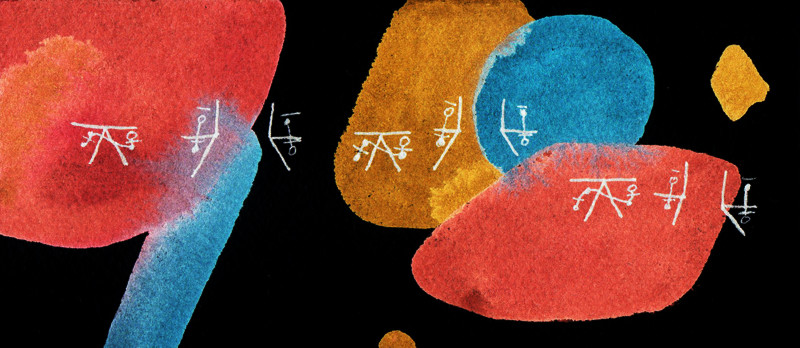
Table of Contents
Introduction⌗
I want to be able to describe tricks that involve props moving around the body, and the body moving around the props.
In this article I suggest a new notation system that can accurately describe such tricks, which builds upon Body Trick Notation (BTN). The working title of this system will be IMproved BOdy trick notation (IMBO).
The easiest juggling patterns happens in front of the juggler, but more complicated ones could involve movement of the props around the body. An example of a body trick is a throw under the opposite arm. This can be executed in different ways, for example the throwing hand can be maneuvered under the arm before the ball gets thrown, or the ball could get thrown normally and the opposite hand traces a path around it whilst the ball is in mid air.
IMBO can describe both of these tricks and many more, and uses normal text characters so that it can easily be shared in messages or used as an input in a juggling simulator.
To make it easier to communicate these tricks there is also a graphical notation, which is intended to be more intuitive to read and write than the text based notation.
IMBO explained⌗
The basics⌗
Just like in BTN, IMBO takes a topological model of a juggler (fig. 1a) and assigns names to the 5 holes that can be imagined between the limbs and head (fig. 1b).
These names are:
Hor High, for the space between the head and the armMor Middle, for the space between the arms and the legsLor Low, for the space between the two legs
These abbreviations can also be remembered with Head, Midriff and Legs instead of High, Middle, and Low.

A hole on the opposite side of the throwing hand is followed by a ~. The side that is referred to as “opposite” does not change during a single throw, which is the same as how it is used in T.A.C. (part of harmonic throws)notation. So if a throw is made by the right hand, H will refer to the right side hole between head and arm and H~ to the left side hole.
A prop always starts and ends in front of the body, with the body starting and ending in anatomical position, just as in BTN. This means that always a multiple of 2 holes must be passed for any body throws, one that takes the prop from the front to the back, and one opposite. It is possible to do multiple front and back passes in a single throw.
The main difference with BTN is that the moment of throwing and catching is denoted. A hole can be passed in 3 different ways: Carried before the throw, in air, or carried after the catch. This is signified by writing the following symbols on the moment of a throw or catch:
/(line going up) a throw\(line going down) a catch
A simple under the leg throw looks like this: M/L\. In verbal language we could call this “middle throw low catch”.
Leg throw variations⌗
With the rules that each path should contain exactly 1 throw and 1 catch and the throw must be made before the catch can be made, we can now make 6 different throw/catch combinations using any 2 hole path such as ML. All 6 are shown here, underneath each description there are 2 videos of the trick: One in which a ball crosses hands and one in which the ball stays in the same hand.
-
ML/\An “under the leg throw” where the throwing hand is fully extended through the hole between leg and arm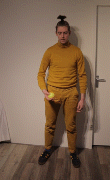
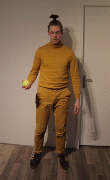
-
M/L\A normal “under the leg throw”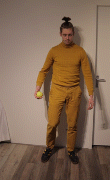

-
M/\LThe prop is carried to the back, then thrown and caught, and carried through the legs to the front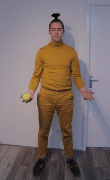
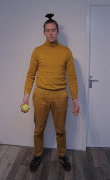
-
/ML\The prop is thrown and then needs to pass both holes before it is caught. The only feasible way to do this with a toss is by lifting the leg over the prop in mid-air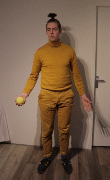
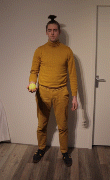
-
/M\LThe prop is thrown from neutral position, passes between the arm and leg, is then caught and carried through the leg hole. This is a normal “under the leg catch”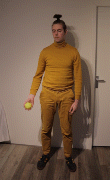
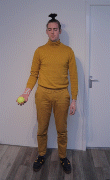
-
/\MLThe prop is thrown and caught, and then carried through both holes to neutral position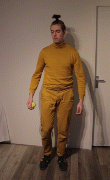
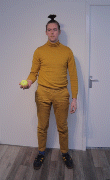
More theory⌗
The exact location of these holes can be vague, especially when a prop is carried or thrown through a hole by an arm on the same side. For example, the non crossing version of /\ML may not make a lot of sense. Therefor slightly different interpretations could be made on the meaning of a IMBO move, and perhaps some details need to be understood through convention rather than through rule. However, now for the first time a clear distinction between an “under the leg throw” and an “under the leg catch”, respectively M/L\ and /M\L can be made without the need for graphics or a detailed description.
Also, new information is found. Never before was there vocabulary to describe these 6 different tricks. Some distinctions might not be very meaningful for jugglers, in case of under the leg throws the first two and the last two in the list above are very similar. However, I believe that M/\L and /ML\ are new and interesting ways to look at under the leg tricks.
It is not notated if a throw is crossing from one side to the other, not which body part (hand, foot, elbow) is making the throw or catch, and not which height a ball is thrown or if it is passed from hand to hand, this information will have to be given by other context. Some pathways will make more or less sense depending on which hand, height and direction the prop has.
If a throw starts and stops on the backside of a jugglers body, for example a “Blind Behind the Back” (BBB) throw, the carry part is still imagined as if the ball were to come and go from the front. So BBB would be M/\M~. If then another throw by the catching hand that starts from the same position as the catch position, for example a second M/\M~ BBB throw, the juggler would be expected to skip the extra back and forth motion and just keep their hands in the back.
Exception positions⌗
There are two more special positions which are only relevant when a ball is being carried to or from them (not if a ball only passes a hole in the air), and only if this is immediately before or after a catch. These form a bit of an exception to the system. They are:
Mpfor Middle PenguinMofor Middle Overhead
When a ball is carried through the M hole there are 3 positions where it could end up which are relevant for juggling. The normal M position takes the hand to the backside of the body, for example for a backcross or an under the leg throw. If you keep twisting your hand forwards you will end in the Mp position. Without this position it would not be possible to distinguish between a penguin catch and an over the shoulder throw. When you take your hand from the penguin position and lift it up over your head you get into Mo position, commonly referred to as overhead, which is again reached by carrying a prop through the same hole but is experienced as a completely different throw or catch by jugglers. With these extra positions you can now make moves such as Mo/\Mp~ which means an overhead throw to a penguin catch. In this rare case we also know that this must be a throw that crosses from one hand to the other, as Mo has to be executed by the hand which the the ball starts in and Mp~ has to be executed by a hand on the opposite side. All of these patterns and positions are shown below:

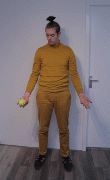
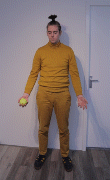

Graphics⌗
The characters H,M,L and H~, M~ were picked so that it would be easy to spot how many holes were crossed in any string. However, even in a longer sequence like MM~/M\L it may still take a moment to process the information and visualize the trick.
To help with this visualization there is a graphical notation of IMBO. This could also help with teaching or explaining the notation system, or help as a tool to discover new body moves.
In the graphical notation the body is represented as 5 lines, with the holes being in between those lines. In this notation the left side is always the ‘same’ side, and the right side is always the ‘opposite’ side (fig. 2). It does not signify if a throw or catch is being made with the left or right hand, just like in the normal notation.

The first hole that is passed is marked with an open circle. Each following hole with a closed circle. The circles are connected with a path line (fig 3a). When holes are unused, the limbs related to that hole do not need to be drawn (fig 3b). Two short lines are added to signify the throw and catch. If the line comes before the circle, the action happens before the prop passes the hole. If it comes after the circle it comes after a hole is passed. Thus, in fig. 3c we see /H\H~ and in fig. 3d we see /HH~\.

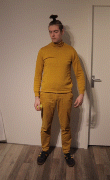

Here is another example with leg throws. Fig. 4a is /M\L, a standard “under the leg catch”, and fig. 4b is M/L\, a standard “under the leg throw. The exact position of the throw or catch line on a path line is irrelevant, we only need to read if it is in front of or behind a hole marker. Thus fig. 4c is equal to fig. 4b.



To draw a path that goes through more than 2 holes one simply adds more closed circles and connects them with the path line in order. Fig. 5a shows MM~/\MM~ which is a “contortion” throw and catch, fig. 5b shows M/LL\M~ which is an “under the leg” throw and catch, and fig. 5c shows L/M~H~HM\L which is an “inside under the leg” throw and catch in which the prop passes behind the neck.

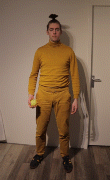

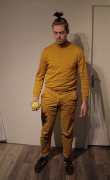
Interactive graphics tool⌗
The graphics have been developed to be easy to draw, but one can also create them with this interactive IMBO graphics tool. Simply enter the IMBO notation in the text bar to get a graphic. It does not check for the validity of a pattern, so it is also possible (but not recommended) to draw paths with an odd amount of holes or more catches and throws.
Please do try it out!
Trick examples⌗
Here are some more examples of tricks and their notations. The graphics in this section are created with the interactive tool above.
Frédéric Roudaut made these 4 variants of neck throws to explain the ambiguity of BTN. They can now be distinguished with IMBO:
- Variant 1:
H/\H~ - Variant 2:
/HH~\ - Variant 3:
/H\H~ - Variant 4:
H/H~\
IMBO also works well for paths traced with limbs around balls in the air. Note the difference between these two under arm tricks:
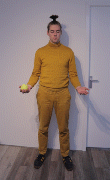
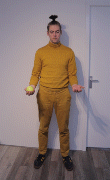
Mills mess is a common juggling trick which consists of 3 unique throws. In the video below there is an orange ball, a purple ball and a yellow ball. Their paths are as follows:
- Orange:
M~/M~M\M - Purple:
/H\M - Yellow:
M~/H~\
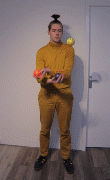
These examples are just the beginning, I hope that one day we’ll have a large database of possible IMBO tricks.
How does IMBO compare to other notation systems?⌗
In order to communicate about tricks and possibly simulate them, we need a common understanding of what makes up a throw, which are its characteristics that set it apart from other throws.
My biggest critique on BTN is that it leaves a lot of ambiguity. Most jugglers distinguish between a throw that is caught under the leg and a throw that is thrown under the leg, but in BTN both are described with ALBOL, and offers no way to distinguish them.
This feature alone makes BTN unsuitable to describe tricks for me, instead it describes pathways only.
My second critique on BTN is that it is hard to read. It uses the terms AC and AL which in my handwriting look very similar, and from a sequence such as OPACALBOLOPAL it is hard to tell in a glance how many holes are passed as all abbreviations have different lengths. (In this case, it refers to 4 holes: OPAC,AL,BOL,OPAL). The use of OP for opposite is often confusing to me as the side which is seen as opposite can switch multiple times in a single throw. Overall there are too many similar letters (multiple L’s, multiple O’s and multiple A’s) in the system to quickly distinguish the abbreviations.
The T.A.C. system, part of Harmonic Throws, is a modified version of BTN and has attempted to solve this second issue in three ways: Using the words ti bi li TO BO instead of AC AL BOL OPAC OPAL makes it shorter and easier to read. For this they propose a shorthand using only the first letters, which leads to combinations such as tT, but this I find less convenient especially when writing patterns by hand, the lower and uppercase version of a letter might be too similar. Luckily they offer a third solution optimized for drawing on paper: Little graphical symbols. I believe the IMBO symbols are slightly better as I consider them to be more intuitive to read, you need to memorize less in order to use them, but this is possibly debatable and IMBO has not been tested as much as T.A.C. has. These graphic symbols are also only able to describe a path through two holes each, unlike mine which can describe a path through infinitely many (in practice you’ll rarely need more than 4).
T.A.C. has done away with the confusing use of OP in BTN, in T.A.C. the TO and BO always refer to opposite of the throwing side, no matter how many holes are crossed. This is the same as in IMBO.
T.A.C. does not solve for the ambiguity as mentioned in my first critique, which Harmonic Throws then solves by adding an extra layer of notation: The Benesh score. This works, but I think it is way too complex for body trick purposes. Also, Benesh is hard to translate to text and thus hard to communicate to others without drawing it.
IMBO can describe all body throws in detail without needing an extra layer of complexity such as Benesh.
One advantage that T.A.C. and BTN possibly do have over IMBO is that it is easier to pronounce the paths. biTO and ALOPAC can be pronounced straight away, wheras M/H~\ needs to be translated to something like “em throw aitch op catch” or “middle throw high opposite catch”. Pronounceability was considered in the design of IMBO, but ultimately dismissed as a requirement in favor of shorter writing and reading.
Another attempt to describe body tricks is SOJUP, which can describe most tricks in more detail than BTN, but because only the holes are described that are passed when the prop is in the air there are even tricks that I believe can be described better in BTN such as BOLALOPALBOL.
Remaining issues⌗
As with any notation, IMBO simplifies the real world and thus is imperfect. Here are some aspects which could possibly be considered a problem for juggling.
It is not noted whether the feet are down on the floor or not. Jugglers distinguish between a leg throw with the leg raised, and a leg throw with both feet planted on the floor which is commonly called a “trebla”. There is a third variation in which the opposite leg is raised. IMBO does not give this information, all extra movement that does not influence the object path is currently considered as “dance”, and needs to be notated in another way. However, I personally have been drawing little feet on the graphical notation in my notebook whenever I wanted to indicate a planted foot.
Juggling props are always considered to start from the front of the body, even if they are already carried to the back. But what if the contact position with the body is on the back side? Not all throws are made from the hand. Is a throw from the back of the hand starting from the front plane or has it already been carried to H? Probably this has to be judged and described on a case by case basis, but perhaps over time jugglers will come up with a standard approach for most positions.
As already mentioned in The basics the hole position can be vague. One could argue that my video of /\ML non-crossing makes very little sense.

There are a lot of special positions that IMBO does not notate. It makes exceptions for penguins and overheads, but there is no such position proposed to differentiate a throw over the opposite arm from a throw over the opposite shoulder, for example. I encourage users of this system to amend it whichever way fits best for them, and perhaps if enough jugglers start to use these amendments they will become part of the “standard” IMBO too.
IMBO does not notate which body part makes the throw or catch, the timing of the throws, or the relationships of props with other props (such as inside or outside throws).
I don’t regard any of these issues as very problematic, after all siteswap does also have a lot of similar flaws (the difference between the siteswaps 3 and 522 could be considered “vague”) and is very successful.